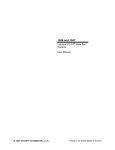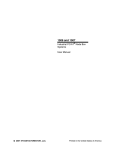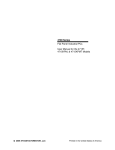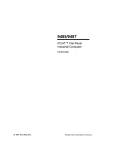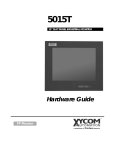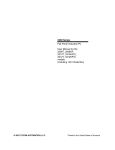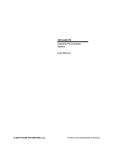Download 5015T/R2 - Pro-face America HMI Store
Transcript
5015T/R2 Flat Panel Industrial Touch Monitor User Manual 2007 XYCOM AUTOMATION, LLC Printed in the United States of America Revision A B C Description Manual Released Revised OSD Menu & Video Modes Name change, correct cutout/dimensions Date 10/05 10/06 04/07 Part Number 144497 (C) Trademark Information Xycom and Xycom Automation are trademarks of Xycom Automation, L.L.C. Xycom Automation, L.L.C. now is referred to as Pro-face through a D.B.A. The Pro-face name and logo will replace the Xycom name and logo on all documents where possible. Pro-face is a trademark of Digital Electronics Corporation. Brand or product names are trademarks or registered trademarks of their respective owners. Intel and Pentium are registered trademarks and Celeron is a trademark of Intel Corporation. Windows, Windows NT, and Windows XP are registered trademarks of Microsoft Corporation in the U.S. and in other countries. Copyright Information This document is copyrighted by Xycom Automation, L.L.C. (Xycom) and shall not be reproduced or copied without expressed written authorization from Xycom Automation, L.L.C. The information contained within this document is subject to change without notice. Pro-face does not guarantee the accuracy of the information. United States FCC Part 15, Subpart B, Class A EMI Compliance Statement: NOTE: This equipment has been tested and found to comply with the limits for a Class A digital device, pursuant to part 15 of the FCC Rules. These limits are designed to provide reasonable protection against harmful interference when the equipment is operated in a commercial environment. This equipment generates, uses, and can radiate radio frequency energy and, if not installed and used in accordance with the instruction manual, may cause harmful interference to radio communications. Operation of this equipment in a residential area is likely to cause harmful interference in which case the user will be required to correct the interference at his or her own expense. WARNING – European Users: This is a Class A product. In a domestic environment this product may cause radio interference in which case the user may be required to take adequate measures. INSTALLATION: Electromagnetic Compatibility WARNING The connection of non-shielded equipment interface cables to this equipment will invalidate FCC EMI and European Union EMC compliance and may result in electromagnetic interference and/or susceptibility levels which are in violation of regulations which apply to the legal operation of this device. It is the responsibility of the system integrator and/or user to apply the following directions, which relate to installation and configuration: All interface cables must include shielded cables. Braid/foil type shields are recommended. Communication cable connectors must be metal, ideally zinc die-cast backshell types, and provide 360-degree protection about the interface wires. The cable shield braid must be terminated directly to the metal connector shell, ground drain wires alone are not adequate. Protective measures for power and interface cables as described within this manual must be applied. Do not leave cables connected to unused interfaces or disconnected at one end. Changes or modifications to this device not expressly approved by the manufacturer could void the user's authority to operate the equipment. 144497 (C) Table of Contents CHAPTER 1 – INTRODUCTION ...................................................................................................................................1 PRODUCT OVERVIEW ....................................................................................................................................................1 Standard Features .................................................................................................................................................1 Unpacking the Unit.................................................................................................................................................1 QUICK STARTUP ...........................................................................................................................................................2 CHAPTER 2 – INSTALLATION.....................................................................................................................................3 PRODUCT DIMENSIONS ..................................................................................................................................................3 5015T/R2 Dimensions............................................................................................................................................3 Front Panel Controls ..............................................................................................................................................4 I/O Panel ................................................................................................................................................................5 LOCATION AND ENCLOSURE CONSIDERATIONS .................................................................................................................6 PANEL INSTALLATION .....................................................................................................................................................7 POWER MANAGEMENT ...................................................................................................................................................9 System Power........................................................................................................................................................9 Excessive Heat ....................................................................................................................................................11 Electrical Noise ....................................................................................................................................................11 Line Voltage Variation ..........................................................................................................................................12 HAZARDOUS LOCATIONS INSTALLATIONS .......................................................................................................................12 Definitions ............................................................................................................................................................14 Power Switch .......................................................................................................................................................16 Cable Connections...............................................................................................................................................16 Operation and Maintenance.................................................................................................................................17 Safety Agency Approval.......................................................................................................................................17 CHAPTER 3 – MONITOR SETTINGS .........................................................................................................................18 ON SCREEN DISPLAY (OSD) SWITCH ...........................................................................................................................18 MODE AND IMAGE ADJUSTMENT ...................................................................................................................................18 Recall the Factory Default Settings ......................................................................................................................21 ANALOG RGB INTERFACE SPECIFICATIONS ...................................................................................................................21 VIDEO MODES ............................................................................................................................................................22 CHAPTER 4 – OPERATOR INPUT.............................................................................................................................23 INSTALLING THE TOUCH SCREEN DRIVER ......................................................................................................................23 CALIBRATING THE TOUCH SCREEN................................................................................................................................24 ACCESSING THE “MOUSE RIGHT BUTTON” FUNCTIONALITY WITH THE TOUCH SCREEN .......................................................24 USING A POINTING DEVICE WITH A TOUCH SCREEN FOR DOS .........................................................................................24 CHAPTER 5 – HARDWARE........................................................................................................................................25 VGA INPUT CONNECTOR .............................................................................................................................................25 DVI-D INPUT CONNECTOR ..........................................................................................................................................26 SERIAL INTERFACE ......................................................................................................................................................26 TOUCH SCREEN RS-232 OUTPUT CONNECTOR.............................................................................................................27 TOUCH SCREEN USB OUTPUT CONNECTOR .................................................................................................................27 HARDWARE SPECIFICATIONS ........................................................................................................................................28 ENVIRONMENTAL SPECIFICATIONS ................................................................................................................................29 BEFORE CONTACTING TECHNICAL SUPPORT ..................................................................................................................30 CONTACTING TECHNICAL SUPPORT ..............................................................................................................................30 PRODUCT REPAIR PROGRAM / RETURNING A UNIT TO PRO-FACE.....................................................................................31 i 144497 (C) Chapter 1 – Introduction Product Overview Pro-face/Xycom industrial flat panel touch monitors offer state-of-the-art performance and features while meeting the rigorous requirements of the plant floor. Pro-face/Xycom’s 5015T/R2 high-resolution flat panel display reflects the latest “Smart Panel” technology and is contained within a rugged housing with a resistive membrane touch screen. Standard Features • 15” Flat Panel TFT XGA supporting resolutions up to 1024x768 • 2.9” mounting depth • Five-wire analog resistive touch screen with either RS-232 or USB interfaces • Front panel controls with on-screen menus (lock-out switch on rear of units) • 24V DC input power (optional) • Stainless steel front bezel (optional) • NEMA 4/4x/12 front panel (when properly mounted) Caution Leaving your TFT LCD display on constantly can result in temporary image retention (TIR). TIR can be avoided by using a screen saver, enabling the idle/doze timeout feature, or by turning off the display when it is not in use. Unpacking the Unit When you remove the 5015T/R2 from its shipping box, verify that you have the parts listed below. Save the box and inner wrapping in case you need to reship the unit. • • • • • • • 5015T/R2 unit Installation Mounting Clip Fastners (14) Spacers (4) P/N 144289 & screws (8) - to mount the 5015T/R2 into an existing XT1502 cutout. Spacers (4) P/N 144290 & screws (8) - to mount the 5015T/R2 into an existing 5015T cutout. Analog VGA Cable (10 ft.) RS-232C Cable (10 ft.) USB Cable (3 m) 1 144497 (C) • Documentation and Support Library CD-ROM, which contains this manual and all drivers required by this unit. Quick Startup This section depicts the steps to get the system up and running without explaining the capabilities and options. Warning Remove power from the unit and disconnect the power cord before making any adjustments to the inside or outside of the monitor. Warning For Hazardous Locations installation, review Hazardous Locations Installation in Chapter 2 before startup. To prepare the system for use, perform the following steps. 1. Attach the appropriate touch cable (USB or RS-232), following the instructions in Chapter 2. 2. Attach the power cord from the power receptacle to a properly grounded 100-240 V AC, 50-60 Hz, or an optional 18-30 V DC power source. (See System Power in Chapter 2 for more information.) 3. Attach the VGA cable. 4. First, turn on power to the 5015T/R2 (via an outlet power switch if applicable). Then turn on power to the host computer. The system will boot up into the operating system. 5. If using touch feature, install drivers on the host computer via the floppy, the CDROM, or the network, as applicable. 2 144497 (C) Chapter 2 – Installation Product Dimensions 5015T/R2 Dimensions Note: All dimensions are in inches. Figure 2-1. 5015T/R2 Dimensions 3 144497 (C) 5015T/R2 Flat Panel Industrial Touch Monitor Chapter 2 – Installation Front Panel Controls Figure 2-2. 5015T/R2 Front Panel Controls Table 2-1. 5015T/R2 Front Panel Controls Functions 1 LCD ON/OFF Power On/Off POWER (LED) Power Indicator On = Power On Off = Power Off Automatically optimize positions, phase & clock when OSD is not shown. Exit the OSD menu when OSD is shown Enter OSD Access sub-menu & selection Selection or adjustment when OSD is shown Quick Volume adjustment (Unused) Adjustment when OSD is shown Quick Volume adjustment (Unused) 2 AUTO 3 MENU 4 LEFT 5 RIGHT 4 144497 (C) 5015T/R2 Flat Panel Industrial Touch Monitor Chapter 2 – Installation I/O Panel Figure 2-3. 5015T/R2 I/O Panel Table 2-2. 5015T/R2 I/O Panel Functions Feature Description AC Input 100-240 VAC auto-ranging Touch output to computer The two following features will be available on all units. Touch Out USB and RS232 USB and RS232 touch screen output OSD Selector Switch Used to enable or disable (lock) adjustment buttons on front of monitor Video Inputs The 5015T/R2 monitor has two video input options: Digital Video Input (DVI), a DVI-D connector, for digital signal input to an analog monitor; VGA Input (VGA), to connect this VGA monitor for standard analog input from a computer. 5 144497 (C) 5015T/R2 Flat Panel Industrial Touch Monitor Chapter 2 – Installation Location and Enclosure Considerations • Account for the unit dimensions when selecting an installation location or enclosure (see page 3 for unit dimensions). • You can maintain the NEMA 4 seal by mounting the unit in an approved enclosure that has a 14-gauge (0.075"/1.9 mm thick) steel or (0.125"/3.2 mm thick) aluminum front face. • Place the unit at a comfortable working level. • Mount the unit in an upright position, if possible. • Consider locations of accessories such as AC power outlets and lighting (interior lighting and windows) for installation and maintenance convenience. • Prevent condensation by installing a thermostat-controlled heater or air conditioner. • Avoid obstructing the airflow to allow for maximum cooling. • Place any fans or blowers close to the heat-generating devices. If using a fan, make sure that outside air is not brought inside the enclosure unless a fabric or other reliable filter is used. This filtration prevents conductive particles or other harmful contaminants from entering the enclosure. • Do not select a location near equipment that generates excessive electromagnetic interference (EMI) or radio frequency interface (RFI) (equipment such as high-power welding machines, induction heating equipment, and large motor starters). • Do not place incoming power line devices (such as isolation or constant voltage transformers, local power disconnects, and surge suppressers) near the system. The proper location of incoming line devices keeps power wire runs as short as possible and minimizes electrical noise transmitted to the unit. • Make sure the location does not exceed the unit's shock, vibration, and temperature specifications (see Environmental Specifications on page 26). • Install the unit so it does not cause a hazard from uneven mechanical loading. • Incorporate a readily accessible disconnect device in the fixed wiring on permanently connected equipment. • Avoid overloading the supply circuit. 6 144497 (C) 5015T/R2 Flat Panel Industrial Touch Monitor Chapter 2 – Installation Panel Installation This monitor should be mounted and used where NEMA 4 and NEMA 12 type enclosures are employed. When mounted properly, the monitor meets or exceeds the sealing requirements set forth in the NEMA 4 and NEMA 12 specifications. The monitor uses "U"-shaped clips and a special gasket to achieve the proper seal. Make a cutout in one of the walls of your NEMA enclosure (see Figure 2-4 for cutout dimensions). Enclosures made of heavier gauge metal work better in that they won't deform or bend as easily when the monitor's sealing gasket is compressed. Figure 2-4. 5015T/R2 Cutout Dimensions 7 144497 (C) 5015T/R2 Flat Panel Industrial Touch Monitor Chapter 2 – Installation Figure 2-5. Mounting Clip Locations The 5015T/R2 chassis has been designed to fit into the cutouts of either the XT1502 or the 5015T. To insure that the 5015T/R2 is properly centered into these cutouts, and to insure a good NEMA seal, spacers and mounting hardware have been included in the documentation kit. Mounting into an XT1502 Opening To mount the 5015T/R2 into the opening originally created for an XT1502, use the four spacers marked 144289. Mount two on each side of the unit (with the screws provided) as shown above. Mounting into a 5015T Opening To mount the 5015T/R2 into the opening originally created for a 5015T, use the four spacers marked 144290. Mount two on the top of the unit and two on the bottom (with the screws provided) as shown above. Mounting into a 5015T/R2 Opening The 5015T/R2 has 14 total mounting clips: 4 on both the top and bottom of the monitor, and 3 mounting clips on both of the sides. Hold the monitor in place while you install the mounting clips (see Figure 2-5 for mounting clip locations). Tighten the clips in a crisscross pattern. This will help 8 144497 (C) 5015T/R2 Flat Panel Industrial Touch Monitor Chapter 2 – Installation to develop an even pressure on the sealing gasket. Tighten the clips until the back of the monitor's front bezel begins to contact the front of the NEMA enclosure (at least 7 in-lbs of torque). Insert the hook section into the slots and tighten the fastener with a screwdriver, as shown. Tighten the clips until the back of the monitor’s front bezel begins to contact the front of the NEMA enclosure (at least 7 in-lbs of torque). Panel Mounting Clip Display Unit Figure 2-6. Fastening the Monitor to the Panel Caution Over-tightening the clips can cause damage to the monitor, which can result in loss of seal integrity. Power Management The monitor is based on the VESA DPMS and the DVI DMPM standards. To activate the monitor's Power Management function, both the video card and the computer must conform to the VESA DPMS standard and the DVI DMPM standard. System Power 9 144497 (C) 5015T/R2 Flat Panel Industrial Touch Monitor Chapter 2 – Installation It is a good practice to use isolation transformers on the incoming AC power line to the system. An isolation transformer is especially desirable in cases in which heavy equipment is likely to introduce noise onto the AC line. The isolation transformer can also serve as a step-down transformer to reduce the incoming line voltage to a desired level. The transformer should have a sufficient power rating (units of volt-amperes) to supply the load adequately. Proper grounding is essential to all safe electrical installations. Refer to the relevant federal, state/provincial, and local electric codes, which provide data such as the size and types of conductors, color codes and connections necessary for safe grounding of electrical components. The code specifies that a grounding path must be permanent (no solder), continuous, and able to safely conduct the ground-fault current in the system with minimal impedance (minimum wire required is 18 AWG, 1 mm). Observe the following practices: • Separate the power and ground (P. E., or Protective Earth) cable from signal cables at the point of entry to the enclosure. To minimize the ground wire length within the enclosure, locate the ground reference point near the point of entry for the plant power supply. • All electrical racks or chassis and machine elements should be Earth Grounded in installations where high levels of electrical noise can be expected. The rack/chassis should be grounded with a ground rod or attached to a nearby Earth structure such as a steel support beam. Connect each different apparatus to a single Earth Ground point in a "star" configuration with low impedance cable. Scrape away paint and other nonconductive material from the area where a chassis makes contact with the enclosure. 10 144497 (C) 5015T/R2 Flat Panel Industrial Touch Monitor Chapter 2 – Installation Power Terminal Block: 100-240 VAC Power Input Terminal Block 18-30 VDC Power Input Terminal Block Number Function 1 AC Line Input 2 AC Neutral Input 3 Protective Earth Ground Number Function 1 + DC Line Input 2 – DC Return Input 3 Protective Earth Ground Caution: Use AWG18 wire or greater for the 5015T/R2’s power cable. Isolate the AC main circuit line, I/O signal lines, and power cord - do not bind or group them together. Excessive Heat To keep the temperature in range, the cooling air at the base of the system must not exceed the maximum temperature specification (see Environmental Specifications on page 29). Allocate proper spacing between internal components installed in the enclosure. When the air temperature is higher than the specified maximum in the enclosure, use a fan or air conditioner to lower the temperature. Electrical Noise Electrical noise is seldom responsible for damaging components, unless extremely high energy or high voltage levels are present. However, noise can cause temporary malfunctions that can result in hazardous machine operation in certain applications. Noise may be present only at certain times, may appear at widely spread intervals, or in some cases may exist continuously. 11 144497 (C) 5015T/R2 Flat Panel Industrial Touch Monitor Chapter 2 – Installation Noise commonly enters through input, output, and power supply lines and may also be coupled through the capacitance between these lines and the noise signal carrier lines. This usually results from the presence of high voltage or long, close-spaced conductors. When control lines are closely spaced with lines carrying large currents, the coupling of magnetic fields can also occur. Use shielded cables to help minimize noise. Potential noise generators include switching components, relays, solenoids, motors, and motor starters. Refer to the relevant Federal, State/Provincial, and local electric codes, which provide data such as the size and types of conductors, color codes and connections necessary for safe grounding of electrical components. It is recommended that highand low-voltage cabling be separated and dressed apart. In particular, AC cables and switch wiring should not be in the same conduit with all communication cables. Line Voltage Variation The power supply section of the unit is built to sustain the specified line fluctuations and still allow the system to function in its operating margin. As long as the incoming voltage is adequate, the power supply provides all the logic voltages necessary to support the monitor unit. Unusual AC line variations may cause undesirable system shutdowns. As a first step to reduce line variations, correct any possible feed problems in the distribution system. If this correction does not solve the problem, use a constant voltage transformer. The constant voltage transformer stabilizes the input voltage to the systems by compensating for voltage changes at the primary in order to maintain a steady voltage at the secondary. When using a constant voltage transformer, check that the power rating is sufficient to supply the unit. Hazardous Locations Installations Pro-face designed this system with the intention of meeting the requirements of Class I, Division 2 and Class II, Division 2 Hazardous Locations applications. Division 2 locations are those locations that are normally non-hazardous, but potentially hazardous should an accident expose the area to flammable vapors, gases or combustible dusts. These systems are non-incendiary devices. They are not intrinsically safe and should never be operated within a Division 1 (normally hazardous) location when installed as described here. Nor should any peripheral interface device attached to these systems be located within Division 1 locations unless approved and/or certified diode barriers are placed in series with each individual signal and DC power line. Any such installations are beyond the bounds of Pro-face design intent. Pro-face accepts no responsibility for installations of this equipment or any devices attached to this equipment in Division 1 locations. It is the responsibility of the customer to ensure that the product is properly rated for the location. If the intended location does not presently have a Class, Division, and Group rating, then users should consult the appropriate authorities having jurisdiction in order to determine the correct rating for that Hazardous Location. 12 144497 (C) 5015T/R2 Flat Panel Industrial Touch Monitor Chapter 2 – Installation In accordance with Federal, State/Provincial, and Local regulations, all hazardous location installations should be inspected by the appropriate authority having jurisdiction prior to use. Only technically qualified personnel should install, service, and inspect these systems. Warning Suitable for use in Class I, Division 2 Groups A, B, C, and D, and Class II, Division 2, Groups F and G hazardous locations or non-hazardous locations only. Temperature Code T6. Warning - Explosion Hazard Substitution of components may impair suitability for Class I, Class II, Division 2. Advertissement Risque D’ Explosion La substitution de composants peut rendre ce materiel inacceptable pour les emplamements de classe I, II, Division 2. Warning - Explosion Hazard Do not disconnect equipment unless the power has been switched off or the area is known to be non-hazardous. Advertissement Risque D’ Explosion Avant de deconnecter l’equipment, coupler le courant ou s’assurer que l’emplacement est designe non dangereux. Warning - Explosion Hazard When in hazardous locations, turn off power before replacing or wiring modules. Advertissement Risque D’ Explosion Dans les situations hasardees, couper la courant avant de remplacer ou de cabler les modules. 13 144497 (C) Definitions The following Class and Division explanations are derived from Article 500 (Sections 5 and 6) of the United States National Fire Protection Agency National Electric Code (NFPA 70). They are not complete and are included here only for a general description for those not familiar with generic hazardous locations’ requirements. Persons responsible for the installation of this equipment in Hazardous Locations are responsible for ensuring that all relevant codes and regulations related to location rating, enclosure, and wiring are met. Class I Locations Class I locations are those in which flammable gases or vapors are or may be present in the air in quantities sufficient to produce explosive or ignitable mixtures. Class II Locations Class II locations are those that are, or may become, hazardous because of the presence of combustible dust. Division 1 Locations A Division 1 location is one in which flammable or ignitable gasses, vapors, or combustible dusts and particles can exist due the following conditions: • Normal operating conditions. • Because of repair, maintenance conditions, leakage, or where mechanical failure or abnormal operation of machinery or equipment might release or cause explosive or ignitable mixtures to be released or produced. • Combustible dusts of an electrically conductive nature may be present in hazardous quantities. Note Pro-face/Xycom 5015T/R2, 5015T/R2-24V systems are not suitable for installation within Division 1 locations. Note Electrical equipment cannot be installed in Division 1 locations unless they are intrinsically safe, installed inside approved explosion-proof enclosures, or installed inside approved purged and pressurized enclosures. 14 144497 (C) 5015T/R2 Flat Panel Industrial Touch Monitor Chapter 2 – Installation Division 2 Locations • Class I volatile flammable liquids or flammable gasses are handled, processed, or used, but confined within closed containers or closed systems from which they can escape only in cases of accidental rupture or breakdown of such enclosures or systems, or in case of abnormal operation of equipment. • Ignitable concentrations of Class I vapors or gasses are normally prevented by positive mechanical ventilation, but which may become hazardous due to mechanical failure of those ventilation systems. • Location is adjacent to a Division 1 location. • Class II combustible dust is not normally in the air in quantities sufficient to produce explosive or ignitable mixtures. Dust accumulations are normally insufficient to interfere with normal operation of electrical equipment or other apparatus. Combustible dust may be in suspension in the air as a result of the following: infrequent malfunctioning of handling or processing equipment; combustible dust accumulations on, or in the vicinity of electrical equipment; may be ignitable by abnormal operation or failure of electrical equipment. Groups All electrical equipment that is approved for use in hazardous locations must include a group rating. Various flammable and combustible substances are divided into these groups as a function of their individual maximum experimental safe gap (MESG), explosion pressure, and ignition temperature. Component temperatures and the potential for spark based upon voltage, current, and circuit characteristics, within electrical equipment, will determine what the equipment group rating will be. A device approved for installation within Class I, Group A locations may also be used in Groups B, C, or D. 15 144497 (C) 5015T/R2 Flat Panel Industrial Touch Monitor Chapter 2 – Installation Power Switch The systems do not have a power switch. The amount of input power required by these systems classifies a power switch as an incendiary device because the voltage and current across the make/break device are capable of creating a spark. Hazardous locations’ regulations require that a power switch rated for ordinary locations may be used if it is located in an area specified as non-hazardous. However, limits in cable length between the workstation and the power switch may apply. Otherwise the switch must be compliant with Class I, Division 1 requirements (intrinsically safe). These switches are built in a manner that prevents the possibility of a spark when contacts are made or broken. Use suitable UL listed and/or CSA Certified Class I, Division 1 switches in hazardous locations. These switches are available from a wide number of sources. It is the responsibility of the customer to ensure that the power switch selected for their installation has the correct hazardous locations rating for the location in which it is installed. Cable Connections Division 2 hazardous locations’ regulations require that all cable connections be provided with adequate strain relief and positive interlock. USB connections can be used when the 5015T/R2 is installed within a suitable enclosure, such that the USB cables are not operator accessible. If the USB cable leaves the enclosure, then it must have adequate strain relief provided by the system integrator/customer. All communication cables should include a chassis ground shield. This shield should include both copper braid and aluminum foil. The D-sub style connector housing should be a metal conductive type (e.g., molded zinc) and the ground shield braid should be well terminated directly to the connector housing. Do not use a shield drain wire. The outer diameter of the cable must be suited to the inner diameter of the cable connector strain relief in order to ensure that a reliable degree of strain relief is maintained. Warning Never connect or disconnect the communication cables while power is applied at either end of the cable. This may result in an incendiary spark. Permanent damage to the workstation communication components may occur. 16 144497 (C) 5015T/R2 Flat Panel Industrial Touch Monitor Chapter 2 – Installation Operation and Maintenance The systems have been designed for compliance with relevant spark ignition tests. However, please note that the workstation front panel contrast adjustment tactile switches and keyboard connector are the only make/break components intended to be exercised by the operator in the course of normal operation. Always observe the following rules with respect to hazardous location installations: 1. Always install the workstations within an enclosure suitable for the specific application. General-purpose enclosures may be acceptable for Class I applications but are never acceptable for Class II applications. Type 4 (IP 65) enclosures are recommended even when not required by regulations. 2. If present, keep enclosure doors or openings closed at all times, to avoid the accumulation of foreign matter inside the workstation. 3. Never subject the unit to any installation or service procedures unless power is removed and the area is known to be non-hazardous. This includes the installation or removal of power cables, communication cables, or removal of the rear cover of the unit. Only technically qualified service personnel should perform all installation and service. These workstations are designed to require no service in the course of normal operation by an operator. Safety Agency Approval The Pro-face systems are designed to meet the following standards: • Underwriters Laboratories Inc., UL 1604 Standard for Safety Electrical equipment for use in Class I and Class II, Division 2, locations • Underwriters Laboratories Inc., UL 508, Information Technology Equipment • Canadian Standard Association, Specification C22.2 No. 213-M1987 Non-incendiary electrical equipment for use in Class I, Division 2 hazardous locations • Canadian Standards Association, Specification C22.2 No. 142 Information Technology Equipment • IEC 60950-1, Information Technology Equipment 17 144497 (C) Chapter 3 – Monitor Settings Caution Leaving your TFT LCD display on constantly can result in temporary image retention (TIR). TIR can be avoided by using a screen saver, enabling the idle/doze timeout feature, or by turning off the display when it is not in use. On Screen Display (OSD) Switch The OSD Select switch is located on the I/O panel (see Figure 2-3) and offers two choices: enable or disable. The keys on the front of the monitor can be locked-out by setting the OSD switch to disable, or unlocked by setting the OSD switch to enable. Caution Please use OSD after confirming the position of the OSD Select Switch. Touch data is transmitted to host while OSD menu is displayed. Mode and Image Adjustment Not all video controllers produce exactly the same video output levels or the same timing. The 5015T/R2T uses onscreen configuration menus to make setup and adjustment easy. The menus are selected and the menu items are adjusted using the buttons located on the front panel of the monitor. With the OSD enabled, follow the general instructions below to navigate through the adjustment menus and make adjustments. Note If your 5015T/R2 monitor has a stainless steel bezel, the OSD controls will be located on the back of the unit. 18 144497 (C) 5019T Flat Panel Industrial Touch Monitor Chapter 3 – Monitor Settings Figure 3-1. Front Panel Control Buttons With the “POWER” light on and video information already displayed on the screen, press MENU to view the onscreen adjustment menu icons. Then use the LEFT or RIGHT to highlight one of the icons. Once the desired icon is highlighted use the MENU key to select the feature in the menu that you want to adjust. Use the LEFT or RIGHT keys to increase or decrease the feature’s value. Use the MENU key to select another feature that you would like to adjust or press the AUTO key to back out of a particular menu. If no features are selected for any of the adjustment menus then pressing the AUTO key will exit the OSD menu. Waiting for a few seconds will also cause the OSD menu to be exited. Below, icons and the associated adjustment features are listed: Brightness 66 Contrast 50 Clock 50 Phase 31 H. Position 53 V. Position 47 Sharpness 1 2 3 4 5 Option Volume 50 Mute Off On Note: This feature is currently not used. 19 144497 (C) 5019T Flat Panel Industrial Touch Monitor Chapter 3 – Monitor Settings 9300 7500 6500 User Red 50 Green 50 Blue 50 English … Français … Deutsch … Español … Italiano OSD Time Out 30 OSD Position 1 2 3 4 5 OSD Transparen 0 Auto Setting Off On Recall No Yes Aspect Ratio 4:3 5:4 Option Analog Digital 20 144497 (C) 5015T/R2 Flat Panel Industrial Touch Monitor Chapter 3 – Monitor Settings Light Enable Off On Light Contrast 72 Light Bright 50 Light H Start 24 Light H Width 50 Light V Start 25 Light V Height 50 Recall the Factory Default Settings Follow these steps to reset the factory default settings for the OSD. 1. Navigate to the menu and highlight Recall. 2. Press RIGHT to choose yes. 3. Press AUTO to reach the Main Menu then press AUTO again to exit the OSD. Analog RGB Interface Specifications • Based on VESA standard, separate analog RGB • 0.7Vp-p positive true typically • Input range: 0.5 to 1.0Vp-p typical with terminal resistance of 75Ω • H sync signal input: TTL level, negative true or positive true • V sync signal input: TTL level, negative true or positive true 21 144497 (C) 5015T/R2 Flat Panel Industrial Touch Monitor Chapter 3 – Monitor Settings Video Modes The following video modes are supported on the 5015T/R2 flat panel SVGA monitor : • 1024 x 768 • 800 x 600 • 640 x 480 NOTE All video modes are non-interlaced. If the monitor is receiving timing signals that are not compatible, [OUT OF TIMING] will appear. Follow your computer’s instruction manual to set the timing so that it is compatible with the monitor. If the monitor is not receiving any signal (synch signal), [NO SIGNAL] will appear. 22 144497 (C) Chapter 4 – Operator Input Installing the Touch Screen Driver Your 5015T/R2 monitor contains an Elo Graphic touch screen and controller. You will have to load the correct touch screen driver on the computer to which you will be connecting the 5015T/R2. The following steps should be performed on that computer. Note The following instructions assume that a web browser is installed on the computer. 1. Insert the Pro-face Documentation and Support Library CD into the CD-ROM drive. 2. If the Doc CD autostarts, proceed to the next step. If the Doc CD does not autostart, open the CD in Windows Explorer and double click on the file “index.html.” 3. Choose “Flat Panel Monitors” from the links at the top of the home page and then choose the “5015T/R2” on the next page. From the 5015T/R2 page, you can download the User Manual and/or the appropriate touch screen driver. 4. Find the driver for your operating system and click on the link. Choose the “Save” button on the resulting dialog box. 5. Type a destination folder in which to save the download and press the “Save” button. The download will be very short. 6. Extract the files from the .zip file just downloaded. i. For the DOS and Windows NT operating systems, only RS-232 touch is supported. Choose the appropriate directory. ii. For Windows 98, directories are created for USB and RS-232. Choose the appropriate directory. iii. For Windows 2000 and XP, the same driver supports both USB and RS-232 touch and only one directory is created. 7. Go to the appropriate sub-directory and follow the instructions in the readme.txt file. If your computer doesn’t have a web browser, open the CD in Windows Explorer and choose the driver zip file for your operating system from the folder: DRIVERS/5015TR2 Copy it to a folder on your computer and follow steps 6 & 7 above. 23 144497 (C) 5015T/R2T Flat Panel Industrial Touch Monitor Chapter 4 – Operator Input Calibrating the Touch Screen You need to calibrate the touch screen in the following cases: • • The cursor does not follow the movement of your finger or pen. You adjust the size of the video image or change the video mode. To calibrate the touch screen, follow the instructions found in the applet: START > SETTINGS > CONTROL PANEL > ELO Note The touch screen and controller is a matched pair calibrated at the factory. If touch screen and controllers are interchanged calibration may be needed. Accessing the “Mouse Right Button” Functionality with the Touch Screen Note The Mouse Right Button functionality is supported on Windows 2000 and Windows XP models with either USB or RS-232 touch screens. It is also supported on Windows 98 models with RS-232 touch screens. It is not supported on any other configurations. Most Windows applications support use of the mouse right button, usually for context sensitive pop-up menus. The Elo touch screen allows the user to access the mouse right button functionality via an icon that can be optionally displayed. By default, the icon is not displayed and every tap of the touch screen is interpreted as a left button. To display the icon, bring up the Elo touch controller applet: START > SETTINGS > CONTROL PANEL > ELO Check the “Display right mouse button” box under the “Mode” tab and press OK. The icon, in the shape of a 2-button mouse, will appear in the upper left corner of the display. The icon can be dragged to any position on the display. Normally, the left button on the icon will be shaded. Tap the right button on the icon to select the mouse right button function. The shading in the icon will switch to the right button. The next tap made on the touch screen will be interpreted as a right button click, rather than the usual left button click. The effect is only for a single tap. The touch screen switches the shading in the icon and changes back to the left button mode after that single tap. Using a Pointing Device with a Touch Screen for DOS The DOS mouse driver must be loaded before loading the touch screen driver if both a mouse and touch screen are to be supported. This applies only to DOS. 24 144497 (C) Chapter 5 – Hardware VGA Input Connector Analog Signal Input Connector Pin (D-sub connector with 15 pins) Table 5-1. VGA Input Connector Pinout D-Shell (Female) Symbol Description 1 PCR Red, analog 2 PCG Green, analog 3 PCB Blue, analog 4 ID2 Reserved for monitor ID bit 2 (grounded) 5 DGND Digital Ground 6 AGND Analog ground red 7 AGND Analog ground green 8 AGND Analog ground blue 9 DDC_5V +5V power supply for DDC (optional) 10 DGND Digital ground 11 IDO Reserved for monitor ID bit 0 (grounded) 12 DDC_SDA DDC serial data 13 HS_IN Horizontal sync or composite sync, input 14 VS_IN Vertical sync, input 15 DDC_SCL DDC serial clock 25 144497 (C) 5015TR2 Flat Panel Industrial Touch Monitor Chapter 5 – Hardware DVI-D Input Connector The DVI-D Input Connector is a D-sub connector with 26 pins (P3). Table 5-2. DVI-D Input Connector Pinout Pin Signal Name Pin Signal Name 1 TMDS Data 2- 2 TMDS Data 2+ 3 Digital ground 4 NC 5 NC 6 DDC Clock 7 DDC Data 8 Analog Vertial Sync 9 TMDS Data 1- 10 TMDS Data 1+ 11 Digital ground 12 NC 13 NC 14 +5V power supply for DDC (optional) 15 Ground (+5, Analog H/V Sync) 16 NC 17 TMDS Data 0- 18 TMDS Data 0+ 19 Digital ground 20 NC 21 NC 22 Digital ground 23 TMDS Clock + 24 TMDS Clock- 25 NC 26 NC NC stands for No Connection Serial Interface RS-232C Data Transmission Speed: 9600 bps Data Length: 8 bits Stop Bit: 1 bit Parity: None 26 144497 (C) 5015TR2 Flat Panel Industrial Touch Monitor Chapter 5 – Hardware Touch Screen RS-232 Output Connector D-sub 9-pin female, Connector set screw: Inch type (4-40 UNC) Table 5-3. Serial Signal Input Connector Pinout Number Symbol Description 1 DCD Data Carrier Detect 2 RX Receive Data 3 TX Transmit Data 4 DTR Data Terminal Ready 5 GND Signal Ground 6 DSR Data Set Ready 7 RTS Request To Send 8 CTS Clear To Send 9 RI Ring Indicator Note Since all serial interface signals are the same on the PC side, use a straight cable to connect the 5015T/R2 to the PC. Touch Screen USB Output Connector Table 5-4. Touch Screen USB Output Pinout Pin Symbol Description 1 VBUS +5V Power 2 D- Data - 3 D+ Data + 4 GND Ground 27 144497 (C) Appendix A – Technical Specifications Hardware Specifications Table A–1. 5015T/R2 Hardware Specifications Characteristic Specification Mechanical* Height 13.78” (350.01 mm) Width 16.48” (418.59 mm) Depth 2.9” (73.66 mm) Weight 15.1 lbs (6.85 kg) Electrical AC Power 100-240 V AC, 0.6A, 50/60 Hz, 27W Nominal DC Power 18-30 V DC, 1.4A maximum, 26W Nominal Front Panel NEMA 4/4X/12 and IP65 Agency Approvals UL Listed 508 1604 Regulatory Compliance cUL Listed CSA-C22.2, #142 CSA-C22.2, #213 CE EN55022 – Class A EN 61000-6-2 EN 61000-3-2 EN 61000-3-3 IEC 60950-1 FCC 47 CFR, Part 15, Class A * See page 3 for detailed dimensions. 28 144497 (C) 5015T/R2 Flat Panel Industrial Touch Monitor Appendix A – Technical Specifications Environmental Specifications Table A-2. 5015T/R2 Environmental Specifications Characteristic Specification Temperature Operating Non-operating 0° to 50° C (32° to 122° F) -20° to 60° C (-4° to 140° F) Humidity Operating 20% to 80% RH, non-condensing Non-operating 20% to 80% RH, non-condensing Operating Sea level to 10,000 feet (3,048 m) Altitude* Non-operating Sea level to 40,000 feet (12,192 m) Vibration 5-2000 Hz Operating 0.006” (0.15 mm) peak to peak displacement 1.0g maximum acceleration Non-operating 0.015” (0.38 mm) peak to peak displacement 2.5g maximum acceleration Shock Operating** 15g peak acceleration, 11 msec duration, ½ sine wave Non-operating 30g peak acceleration, 11 msec duration, ½ sine wave * Consistent with internal component specifications 29 144497 (C) Appendix B – Technical Support Pro-face Technical Support offers a variety of support options to answer any questions on Pro-face products and their implementation. Before Contacting Technical Support Refer to the relevant chapter(s) in your documentation for a possible solution to any problem you may have with your system. If you find it necessary to contact Technical Support for assistance, please have the following information at hand: 1. Serial number and model number. 2. The operating system type and version (i.e., Microsoft Windows NT version 4.0). 3. Exact wording of system error messages encountered. 4. Any relevant output listing from the Microsoft Diagnostic utility (MSD) or other diagnostic applications. 5. Details of attempts made to rectify the problem(s) and results. 6. The log number assigned from Pro-face Technical Support if this is an ongoing problem. 7. The name of the Technical Support Engineer with whom you last spoke, if known. Contacting Technical Support Internet/Email Website: http://www.profaceamerica.com. This site contains the newest product datasheets, references by industrial sector, application notes, and a link to email technical support. Email: [email protected]. Phone/Fax Pro-face Technical Support: Phone: 734-944-0482. Fax: 734-429-1010, Attention – Technical Support 30 5017T Flat Panel Industrial Touch Monitor Appendix B – Technical Support Product Repair Program / Returning a Unit to Pro-face Pro-face’s Product Repair & Customization Department (PR&C) restores equipment to normal operating condition and implements engineering changes that enhance operating specifications. Pro-face tests products returned to Pro-face with the standard Pro-face test diagnostics. Follow the steps below to prepare the unit for shipment: 1. Obtain an RMA number for your unit via the Pro-face RMA Request Page at http://www.profaceamerica.com/rma// or by calling your nearest Pro-face Repair Department or Xycom Automation, L.L.C. at 734-944-0482. 2. Please have the following information: • Company name, shipping and billing address • Type of service desired: product repair or product exchange • Product model number, part number, quantity, serial number(s), and warranty status • Failure mode and failure systems • Purchase order number or repair order number 3. Make sure the front panel assembly is properly attached to the unit. 4. Attach failure information to the unit to speed processing. 5. Place the unit securely in its original packaging or an equivalent heavy-duty box. 6. Mark the RMA number on your purchase order and on the outside of the box. 7. Send the unit to the address given when you receive your RMA number. 31 144497 (C) 144497 (C) Xycom Automation, L.L.C. Canada Sales: (905) 607-3400 734-429-4971 Northern Europe Sales: +44-1604-790-767 Fax: 734-429-1010 Southern Europe Sales: +39-011-770-53-11 http://www.profaceamerica.com







































